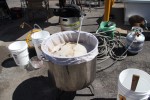 As Against the Grain spends more and more time playing with our nascent All Funked Up series of wild and sour beers, I find myself spending more thought and energy on the one feature that makes those beers simultaneously so alluring and so dangerous to create: bugs. There is a great deal to be said about the care that needs to be taken when employing these insidious little armies, and every brewer seems to have a slightly different opinion (often accompanied by an anecdotal tale or two) about why more or less care is necessary to wrangle unusual organisms. That, however, is not the topic today. Before we get into practical applications, let’s take a good, albeit superficial, look at the actual biology we may or may not employ.
As Against the Grain spends more and more time playing with our nascent All Funked Up series of wild and sour beers, I find myself spending more thought and energy on the one feature that makes those beers simultaneously so alluring and so dangerous to create: bugs. There is a great deal to be said about the care that needs to be taken when employing these insidious little armies, and every brewer seems to have a slightly different opinion (often accompanied by an anecdotal tale or two) about why more or less care is necessary to wrangle unusual organisms. That, however, is not the topic today. Before we get into practical applications, let’s take a good, albeit superficial, look at the actual biology we may or may not employ.
While there are, at a minimum, dozens of different genera responsible for the good and bad flavors that can show up in some of your favorite (or most hated) beers, today we are just going to look at four: saccharomyces, lactobacillus, pediococcus, and the beloved brettanomyces. What’s more, we are going to stay pretty general at the genus level. There can be some radical variation within each of these when you look at the particular species, but that may have to wait for later. If a genus intrigues you, let me know and I will look into an article on the various species thereof.
Saccharomyces – The most commonly employed brewing microorganism, saccharomyces (or beer/brewer’s yeast) is a fungus responsible for the bulk of the fermentation in the vast majority of beers in the modern world. When you hear the word “yeast” in connection to brewing, it is almost always referring to a strain of saccharomyces. The primary activity of this yeast is to take most of the sugars in wort, including maltose and glucose, and turn them into alcohol and carbon dioxide. Other minimal by-products can include acetic acid and enzymes that enable the esterification of those acids in the presence of alcohol. Those esters are largely responsible for what we perceive as “yeast flavors” in beer.
Saccharomyces, while able to perform its function extremely quickly and in extremely high-alcohol environments (sometimes up to 25%), can be quite particular about some other environmental conditions. Dissolved oxygen, as well as a variety of trace minerals are necessary for beer yeast to do its best work. pH levels above 4.5 are also required as more acidic environments can be lethal to beer yeast. Lastly, saccharomyces has a relatively narrow range of tolerable temperatures. Some members of the genus can operate between 40 and 95 degrees Fahrenheit, although particular species often have much narrower ideal temperature ranges.
Lactobacillus – One of two bacteria on this list, lactobacillus is an organism commonly employed to bolster the “sour” part of the “wild and sour” moniker. The primary metabolic activity of lactobacillus is to take in a variety of sugars, including the lactose that saccharomyces cannot ferment, and produce lactic acid and carbon dioxide. Lactic acid, as well as many of its catalyzed ester by-products, is responsible for much of the tartness associated with sour beers and is generally regarded as softer and more palatable than the sharper, more vinegary acetic acid also commonly found in sour beers. One negative by-product to watch out for is a moderate amount of diacetyl, which is considered an off-flavor in most beer styles.
This bacterial metabolism, while not as rapid as saccharomyces fermentation, is still quite quick and can occur at a considerably broader temperature range from 60 to 140 degrees Fahrenheit and at slightly higher levels of acidity. Dissolved oxygen, as well as atmospheric oxygen, however, can significantly slow lactobacillus’ functions, and alcohol levels over 8% can kill it completely. The presence of hop acids can also very significantly retard the growth of some examples of this organism.
Pediococcus – The other bacteria on the list, pediococcus is also a lactic acid producer, although it does not produce carbon dioxide to accompany it. Fermenting primarily glucose, pediococcus can generate about twice as much lactic acid as lactobacillus, making it dangerous if allowed to act unchecked. It can also produce levels of diacetyl far in excess of the human detection threshold. This means that it is best used when extreme tartness is desired and when there are diacetyl removal plans down the road for the beer.
An extremely slow acting but highly resilient organism, pediococcus can take months or even years to do its work and can do so in temperatures ranging from 45 to 140 degrees Fahrenheit. High acidity and the presence of moderate amounts of hop acids also pose relatively little problem for this little guy, but dissolved oxygen can be extremely toxic.
Brettanomyces – Perhaps the most widely touted funky beer organism, brettanomyces is also often referred to simply as “wild yeast”. As a superattenuator, this fungus will metabolize damn near anything. That may be a bit of an exaggeration, but it will eat nearly any sugar in wort. In fact, it can even produce enzymes that will break down proteins and carbohydrates into sugars so it can eat those. It will eat other yeast cells, convert the cellobiose in toasted barrels into food, and even absorb diacetyl. In exchange for eating up basically everything in wort, brettanomyces produces an astounding array of esterizing enzymes as well as both lactic and, under aerobic conditions, acetic acid. The flavors resulting from this fermentation can be extremely complex, varied, and pleasant.
This fungus acts on roughly the same lengthy timetable as pediococcus and can survive the same acidic conditions, but its alcohol tolerance is considerably higher, sometimes being able to survive up to 18% alcohol solutions. As mentioned above, the presence of oxygen is not necessarily detrimental to brettanomyces’ activities but will cause the creation of acetic acid. It also prefers the more moderate temperatures favored by saccharomyces over the warmer and broader temperature ranges of the bacteria.
Well, that was a mouthful. Next time you drink a good beer, give thanks to the (extremely) little guys that made it happen. Until then, faithful readers, thanks for reading, and happy drinks!
P.S. Remember to let me know if you have some specific topic you would like me to babble about next time. You can tell me in person, by e-mail, or in the comments right down below.





